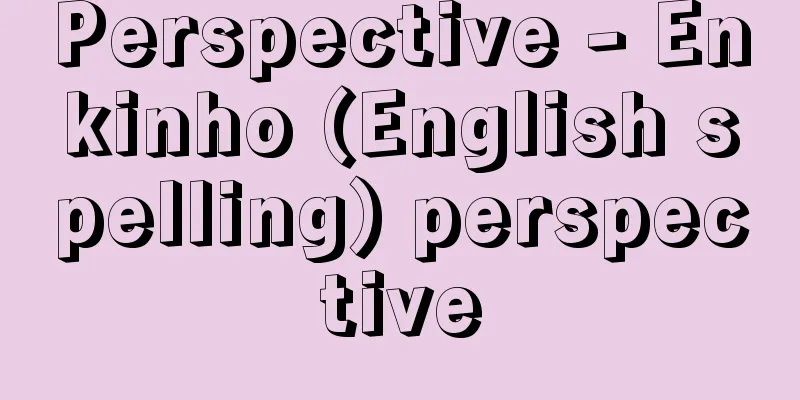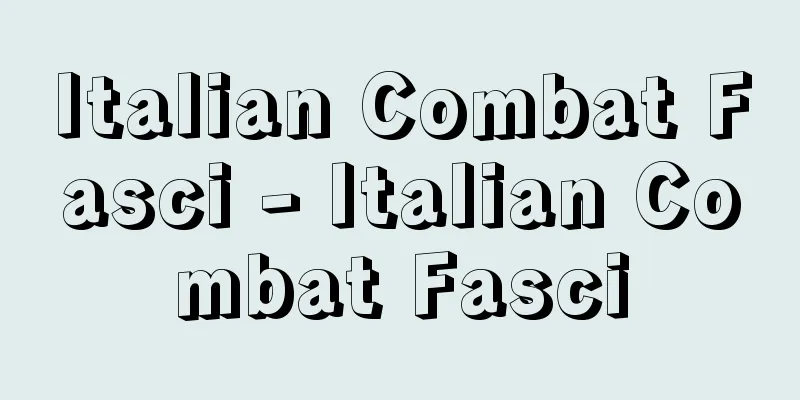Perspective - Enkinho (English spelling) perspective

|
A method of pictorially expressing three-dimensional space on a two-dimensional plane. In the narrow sense, it refers to the mathematical and geometrical perspective method, known as linear perspective, established during the Renaissance. However, even in non-realistic paintings, some techniques were used to implicitly or symbolically express the relationship between depth and perspective, and even in realist paintings, apart from linear perspective, perspective expression through color, known as aerial perspective and color perspective, was explored to express the depth of space. Furthermore, the application of perspective is inevitably seen in reliefs, which have a semi-pictorial effect. These are collectively called perspective. Linear perspective, which was established during the Renaissance and is the core of perspective, was born out of the era's goal of realistically recreating nature, and as a continuation of the theories of Euclid and Vitruvius from the ancient world. In the late Middle Ages, when artists began to aim to recreate nature, they learned of linear perspective and vanishing points through experience and intuition, and artists such as Jean Fouquet used the field of view of a curved mirror. It was the Italian Renaissance artists who scientifically and systematically founded and methodized this empirical perspective. Around 1417, the architect Brunelleschi achieved a scientific approach to linear perspective and vanishing points through his first experimental attempt, and the first realization of this in painting was Masaccio's mural "Trinity" at the Santa Maria Novella Basilica in Florence. Furthermore, under the influence of this mural, the architect Alberti published "De Pictorum" (1436), which set out the first theory of perspective. The book was dedicated to his friends Brunelleschi, Masaccio, Donatello and Ghiberti, all artists who explored perspective, and in it Alberti defined perspective as "a cut-off surface of the cone of vision". Alberti later became friends with Piero della Francesca, who also used perspective as the core of his composition and clear visual expression. He produced masterpieces such as "The Flagellation of Christ" and also summarized the theory of his time in "Perspective in Painting" (1475). The exploration of linear perspective was continued by German artists such as Dürer, and it played such an important role as a central theme of painting until the Mannerism and Baroque eras that it even influenced the composition and style of works. For example, foreshortening, trompe l'oeil techniques, changes in composition using two-point and three-point perspective, and hidden pictures using reverse perspective are also examples. Leonardo da Vinci also had a deep interest in perspective and left many notes about his exploration of it, but he particularly focused on color perspective and vanishing perspective. Linear perspective is suitable for depicting interior spaces, architecture, and cityscapes, but it is hardly effective when depicting natural spaces or landscapes. For example, the contemporary German painter Altdorfer arranged trees like columns to create a rectangular space that was just like an interior space, but this only had a partial effect. Leonardo noticed that the colors of the distant, middle, and foreground views differ depending on the depth of the atmosphere, and that the shapes of objects gradually become blurred, and he proposed color perspective and vanishing perspective, which he applied to his works. This type of perspective had already been attempted in oriental landscape painting, and examples of Leonardo's method include the "three fars" method of high far, deep far, and flat far established by the Chinese Song Dynasty (11th century) painter Guo Xi in his "Linquan Gaozhi," the "three fars" method by Han Zhuo, and the depiction of near and near by the use of light and dark ink in ink painting in general. The depiction of near and near by Guo Xi and others is a kind of bird's-eye view drawing, in which the more distant an object is, the higher it is placed, and it is interesting to note that Leonardo also attempted this method. In medieval Western paintings and Oriental paintings, reverse perspective is sometimes used, in which the further away the lines of a dining table or tatami mat are, the wider they become. In general, non-realistic paintings often have several viewpoints set for a single picture plane or even for a single object. This corresponds to the multi-perspective analysis of objects that came later in Cubism, and artists such as Dali depicted objects in an extremely realistic way, while setting multiple viewpoints on the picture plane to create psychological confusion. In this way, perspective is not simply used to reproduce the illusion of reality on the picture plane, but is merely one example that is related to all expressive techniques, including the artist's mental expression. [Kimio Nakayama] Source: Shogakukan Encyclopedia Nipponica About Encyclopedia Nipponica Information | Legend |
|
三次元の空間を、二次元の平面上に絵画的に表現する方法。狭義には、ルネサンス期に確立された数学的、幾何学的な透視図法、いわゆる線遠近法をさす。しかし、非写実主義絵画においても、なんらかの手法によって奥行、遠近の関係を暗示的、象徴的に表現する手法がとられたし、また写実主義絵画においても、線遠近法とは別個に、空間の深さを表すために、色彩による遠近表現、いわゆる空気遠近法、色彩遠近法が探究されている。また、なかば絵画的効果をもつ浮彫りにも、必然的に遠近法の適用がみられる。これらを総称して遠近法と名づけている。 遠近法の中核となるルネサンス期に確立された線遠近法は、写実主義的な自然再現というこの時代の課題のもとに、そして古代世界のユークリッドやウィトルウィウスの理論の継承という形で生まれた。すでに中世後期、自然再現がしだいに画家たちの目標となりだした時期、彼らは体験的、直観的に、線遠近法、消失点の存在を知り、またジャン・フーケのように曲面鏡の視野などを利用している。こうした経験的な遠近法を科学的、体系的に基礎づけ方法化したのが、イタリア・ルネサンスの芸術家たちである。1417年ごろ、建築家ブルネレスキが最初の実験的な試みによって線遠近法と消失点への科学的なアプローチを成し遂げたあと、絵画での最初の実現は、マサッチョによるフィレンツェのサンタ・マリア・ノベッラ聖堂の壁画『三位(さんみ)一体』で果たされる。さらに、この壁画の影響下に、建築家アルベルティが最初の遠近法の理論を述べた『絵画論』(1436)を出版する。この書物はブルネレスキ、マサッチョ、ドナテッロ、ギベルティらの友人に献呈されたが、いずれも遠近法の探究を試みた芸術家たちである。アルベルティはこの書物で、「視覚の円錐(えんすい)の截断(せつだん)面」として遠近法を定義づけた。 アルベルティはのちにピエロ・デッラ・フランチェスカと交友するが、この画家も遠近法を画面の構図法なり明晰(めいせき)な視覚表現の核とした画家であり、『キリストの笞打(むちう)ち』などの大作を残す一方、『絵画の遠近法』(1475)によって、当時の理論を集大成している。その後も線遠近法の探究はドイツのデューラーたちによってもさまざまに実験され、マニエリズム、バロックの時代まで、絵画の中心的な課題として、作品の構図や様式にさえ関連するほどの重要性を担った。たとえば、短縮や、トロンプ・ルイユ(だまし絵)の技法、あるいは2点透視や3点透視法による構図の変化などもそれであり、また遠近法を逆用した隠し絵などもある。 レオナルド・ダ・ビンチも遠近法に深い関心をもち、その探究についてのノートを多く残しているが、とりわけ彼の考察の対象となったのは、色彩遠近法および消失遠近法である。線遠近法は、室内空間や建築、都市風景を描くのに適しているが、自然空間、風景を対象とする場合、ほとんど効果をもたない。たとえば、同時代のドイツの画家アルトドルファーは、樹木を柱列のように配して、ちょうど室内空間のような方形の空間を想定したりしているが、部分的な効果しかもたない。レオナルドは、遠景、中景、近景が、大気の深さによって色彩の異なること、また物体の形がしだいにかすむことに注目し、色彩遠近法、消失遠近法を提示し彼の作品に応用している。 この種の遠近法は、すでに東洋の山水画において試みられていることであり、中国宋(そう)代(11世紀)の画家郭煕(かくき)の『林泉高致』で定立された高遠、深遠、平遠の「三遠」の法、あるいは韓拙(かんせつ)による「三遠」、そして一般に水墨画における墨の濃淡による遠近の描出などが、レオナルドの方法に対応する先例である。郭煕たちの遠近描出は一種の俯瞰(ふかん)図法であって、遠いものほど上に重ねる手法であるが、レオナルドもまたこの手法を試みていることは興味深い。 西洋の中世絵画や東洋の絵画では、食卓や畳の線が遠くなればなるほど広がる逆遠近法が用いられる場合もある。また、一般に非写実主義絵画では、しばしば、一つの画面なり、一つの物体に対してさえ、視点をいくつか設定している例がみられる。これは、のちにキュビスムの多視点的な対象分析に対応するし、またダリなどは、きわめて写実主義的手法で物体を描写しつつ、画面に複数の視点を設定して、心理的な錯乱を意図している。このようにみると、遠近法は単に画面に現実のイリュージョンを再現するためのものではなく、画家の精神的な表現を含めたすべての表現技法にかかわってくる一例でしかないといえよう。 [中山公男] 出典 小学館 日本大百科全書(ニッポニカ)日本大百科全書(ニッポニカ)について 情報 | 凡例 |
>>: Distant silver point - Enginten
Recommend
Mazar-i Sharif
The largest city in the Afghan Turkestan region in...
Academie Schuiß - Academie Schuiß
...Especially in France, with the rise of Neoclas...
Storehouse - Osame-dono
〘noun〙① A place to store valuables such as gold an...
Coney Island
A seven-mile (11 km) stretch of sandy beach on the...
Itosho
A manor in Ito and Shima counties in Chikuzen Prov...
Retrial - Saishin
It is an emergency relief procedure against a fin...
Gilbart, JW
…He was involved in the establishment of the Nati...
Kiku Peninsula
A peninsula located at the northeastern tip of Ky...
Squall line
According to the definition adopted by the World ...
Kiraigo - Kiraigo
A folk art form. Bon Kyogen is handed down in Kos...
cnidoblast
…A microscopic structure found in all coelenterat...
Senri Hills
A hilly area in the northern part of the Osaka Pl...
Returning from the mountain
The title of a Kabuki dance piece. Kiyomoto. The o...
Crime and Punishment - Tsumi to Batsu (English) Crime and Punishment
A full-length novel by the Russian author Dostoev...
Tounen (current year) - Tounen (English spelling) rufous-necked stint
A bird of the family Scolopacidae, order Charadrii...









